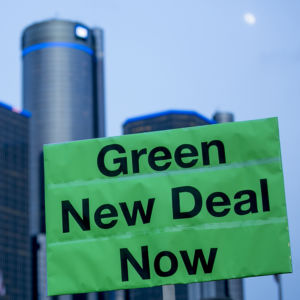What could prove to be the largest IPO ever is on deck for a few weeks from now — in early December — and it doesn’t involve anything that’s green. Well, other than money.
The Saudi royal family is taking the Saudi Arabian Oil Company — Aramco — public. Or at least a small piece of it. About 2 percent will be sold when the shares become available on the kingdom’s stock exchange, the Tadawul.
The whole is estimated to be be worth as much as $2.3 trillion by Goldman Sachs. Saudi Crown Prince Mohammad bin Salam says $2 trillion.
Even if the company’s actual worth turns out to be lower by nearly $1 trillion, analysts say it would still be the most valuable publicly traded company in the world, worth more than Apple by a decent margin and ExxonMobil by a huge one.
Saudi Aramco produces about a tenth of the world’s oil supply — and the small slice of the company that is going up for sale could generate as much as $30 billion. If it does, it would establish a record for IPOs — besting the $22 billion to $25 billion raised by Chinese e-commerce conglomerate Alibaba back in 2014.
Bloomberg says a prospectus will be released by Aramco soon.
The Saudi royal family — which effectively owns Aramco — is reportedly planning to use some of the billions raised by the IPO to deal with problems such as persistent and persistently high unemployment, which currently stands at 12.8 percent (about four times the U.S. rate) and also to fund internal improvements such as the building of Neom, a planned “city of the future” in the northern Tabuk province with flying cars and robotic dinosaurs, among other things — all supposedly powered by “green” renewables.
The tab for all that? Something on the order of $500 billion.
But the most interesting thing about the Aramco IPO — if it does generate the tsunami of cash most analysts expect it to — is what it says about the future of oil as a source of energy. It’s fine to talk up the virtues of “green” alternatives but the fact is that all of them have required the strong arm of government to get going, using cash extracted from the pockets of unwilling “investors” — i.e., taxpayers.
They pay, and the government buys.
Often at grotesquely over-inflated prices, as has come to light most recently in the Pacific Gas & Electric fiasco in California. Huge sums were “invested” — by government mandate — in solar and wind turbine energy generation schemes that cost the people who were forced to pay for them even more than what they paid for them in taxes — in the form of higher utility bills and no electricity.
PG&E resorted to turning off the power to avoid fires that could have been triggered by poorly maintained cables and uncut brush. The fires happened anyhow.
Another obvious example of green wealth redistribution is the heavy subsidization of electric cars, which are a very hard sell without some giving away of other people’s money.
This takes the form of paying people to buy electric cars — or rather paying them off, via massive tax rebates — used to offset the otherwise unpalatable price of electric cars. Ironically, most of the people taking advantage of the subsidies are affluent since even with the $7,500 per car federal rebate/kickback, the least expensive EV (Nissan’s Leaf) still costs its owner about $5,000 more than a well-equipped non-electric economy car.
Meanwhile, most of the people subsidizing all of this are the working- and middle-class taxpayers who can’t afford an electric car, even with the kickbacks they helped pay.
It’s worth a mention that Chuck Schumer just recently proposed increasing the bribes to as much as $10,000 per EV, which he considers a price worth paying to get people out of oil burners and into coal and natural gas burners (about two-thirds of the electricity generated in this country is produced at utility plants that burn fossil fuels).
Never mind.
The macro point is it’s very hard to find anyone willing to put their own money — at market price — on the table for “green” anything. This is what cops sometimes call a clue.
It indicates the market for green is highly artificial, a kind of Potemkin Village propped up by government force.
The market will soon render its verdict about the future of oil. And it looks like it’s going to be a gusher.

